Optical Attenuation Coefficient Optimization Algorithm for Deep Tissue Signals in Optical Coherence Tomography Based on Kalman Filter
Abstract
1. Introduction
2. Method
2.1. Optical Attenuation Coefficient (OAC) Calculation
2.2. The Noise Analysis of OCT
2.3. Classic Kalman Filter
2.4. Kalman Filter for OCT Signals
3. Result
3.1. Numerical Simulations
3.2. Phantom Experiments
3.3. In Vivo Experiments
4. Discussion
5. Conclusions
Author Contributions
Funding
Institutional Review Board Statement
Informed Consent Statement
Data Availability Statement
Conflicts of Interest
References
- Huang, D.; Swanson, E.A.; Lin, C.P.; Schuman, J.S.; Stinson, W.G.; Chang, W.; Hee, M.R.; Flotte, T.; Gregory, K.; Puliafito, C.A.; et al. Optical coherence tomography. Science 1991, 254, 1178–1181. [Google Scholar] [CrossRef]
- Chen, Z.; Milner, T.E.; Srinivas, S.; Wang, X.; Malekafzali, A.; Van Gemert, M.J.C.; Nelson, J.S. Noninvasive imaging of in vivo blood flow velocity using optical Doppler tomography. Opt. Lett. 1997, 22, 1119–1121. [Google Scholar] [CrossRef] [PubMed]
- Leitgeb, R.A.; Schmetterer, L.; Drexler, W.; Fercher, A.F.; Zawadzki, R.J.; Bajraszewski, T. Real-time assessment of retinal blood flow with ultrafast acquisition by color Doppler Fourier domain optical coherence tomography. Opt. Express 2003, 11, 3116–3121. [Google Scholar] [CrossRef]
- Wang, R.K. Optical Microangiography: A Label Free 3D Imaging Technology to Visualize and Quantify Blood Circulations within Tissue Beds in vivo. IEEE J. Sel. Top. Quantum Electron. 2010, 16, 545–554. [Google Scholar] [CrossRef]
- Wang, R.K.; An, L.; Saunders, S.; Wilson, D.J. Optical microangiography provides depth-resolved images of directional ocular blood perfusion in posterior eye segment. J. Biomed. Opt. 2010, 15, 020502. [Google Scholar] [CrossRef] [PubMed]
- Schmitt, J.M. OCT elastography: Imaging microscopic deformation and strain of tissue. Opt. Express 1998, 3, 199–211. [Google Scholar] [CrossRef]
- Larin, K.V.; Sampson, D.D. Optical coherence elastography-OCT at work in tissue biomechanics. Biomed. Opt. Express 2017, 8, 1172–1202. [Google Scholar] [CrossRef] [PubMed]
- Oldenburg, A.L.; Wu, G.; Spivak, D.; Tsui, F.; Wolberg, A.S.; Fischer, T.H. Imaging and Elastometry of Blood Clots Using Magnetomotive Optical Coherence Tomography and Labeled Platelets. IEEE J. Sel. Top. Quantum Electron. 2011, 18, 1100–1109. [Google Scholar] [CrossRef]
- Grulkowski, I.; Liu, J.J.; Potsaid, B.; Jayaraman, V.; Lu, C.D.; Jiang, J.; Cable, A.E.; Duker, J.S.; Fujimoto, J.G. Retinal, anterior segment and full eye imaging using ultrahigh speed swept source OCT with vertical-cavity surface emitting lasers. Biomed. Opt. Express 2012, 3, 2733–2751. [Google Scholar] [CrossRef]
- MMogensen, M.; Thrane, L.; Jørgensen, T.M.; Andersen, P.E.; Jemec, G.B. OCT. OCT imaging of skin cancer and other dermato-logical diseases. J. Biophotonics 2009, 2, 442–451. [Google Scholar] [CrossRef] [PubMed]
- Qin, J.; Shi, L.; Wang, H.; Reif, R.; Wang, R.K. Functional evaluation of hemodynamic response during neural activation using optical microangiography integrated with dual-wavelength laser speckle imaging. J. Biomed. Opt. 2014, 19, 026013. [Google Scholar] [CrossRef] [PubMed]
- Liu, S.; Sotomi, Y.; Eggermont, J.; Nakazawa, G.; Torii, S.; Ijichi, T.; Onuma, Y.; Serruys, P.W.; Lelieveldt, B.P.F.; Dijkstra, J. Tissue characterization with depth-resolved attenuation coefficient and backscatter term in intravascular optical coherence tomography images. J. Biomed. Opt. 2017, 22, 096004. [Google Scholar] [CrossRef]
- Xu, C.; Schmitt, J.M.; Carlier, S.G.; Virmani, R. Characterization of atherosclerosis plaques by measuring both backscattering and attenuation coefficients in optical coherence tomography. J. Biomed. Opt. 2008, 13, 034003. [Google Scholar] [CrossRef] [PubMed]
- Van Der Schoot, J.; Vermeer, K.A.; de Boer, J.F.; Lemij, H.G. The effect of glaucoma on the optical attenuation coefficient of the retinal nerve fiber layer in spectral domain optical coherence tomography images. Investig. Ophthalmol. Vis. Sci. 2012, 53, 2424–2430. [Google Scholar] [CrossRef] [PubMed]
- Scolaro, L.; McLaughlin, R.A.; Klyen, B.R.; Wood, B.A.; Robbins, P.D.; Saunders, C.M.; Jacques, S.L.; Sampson, D.D. Parametric imaging of the local attenuation coefficient in human axillary lymph nodes assessed using optical coherence tomography. Biomed. Opt. Express 2012, 3, 366–379. [Google Scholar] [CrossRef] [PubMed]
- Cauberg, E.C.; de Bruin, D.M.; Faber, D.J.; de Reijke, T.M.; Visser, M.; de La Rosette, J.J.; van Leeuwen, T.G. Quantitative measurement of attenuation coefficients of bladder biopsies using optical coherence tomography for grading urothelial carcinoma of the bladder. J. Biomed. Opt. 2010, 15, 066013. [Google Scholar] [CrossRef]
- Zhao, Q.; Zhou, C.; Wei, H.; He, Y.; Chai, X.; Ren, Q. Ex vivo determination of glucose permeability and optical attenuation coefficient in normal and adenomatous human colon tissues using spectral domain optical coherence tomography. J. Biomed. Opt. 2012, 17, 105004. [Google Scholar] [CrossRef]
- Baran, U.; Zhu, W.; Choi, W.J.; Omori, M.; Zhang, W.; Alkayed, N.J.; Wang, R.K. Automated segmentation and enhancement of optical coherence tomography-acquired images of rodent brain. J. Neurosci. Methods 2016, 270, 132–137. [Google Scholar] [CrossRef]
- Baran, U.; Li, Y.; Wang, R.K. In vivo tissue injury mapping using optical coherence tomography based methods. Appl. Opt. 2015, 54, 6448–6453. [Google Scholar] [CrossRef]
- Vermeer, K.A.; Mo, J.; Weda, J.J.A.; Lemij, H.G.; de Boer, J.F. Depth-resolved model-based reconstruction of attenuation coefficients in optical coherence tomography. Biomed. Opt. Express 2014, 5, 322–337. [Google Scholar] [CrossRef]
- Smith, G.T.; Dwork, N.; O’Connor, D.; Sikora, U.; Lurie, K.L.; Pauly, J.M.; Ellerbee, A.K. Automated, Depth-Resolved Estimation of the Attenuation Coefficient From Optical Coherence Tomography Data. IEEE Trans. Med. Imaging 2015, 34, 2592–2602. [Google Scholar] [CrossRef] [PubMed]
- Liu, J.; Ding, N.; Yu, Y.; Yuan, X.; Luo, S.; Luan, J.; Zhao, Y.; Wang, Y.; Ma, Z. Optimized depth-resolved estimation to measure optical at-tenuation coefficients from optical coherence tomography and its application in cerebral damage determination. J. Biomed. Opt. 2019, 24, 035002. [Google Scholar] [CrossRef]
- Li, K.; Liang, W.; Yang, Z.; Liang, Y.; Wan, S. Robust, accurate depth-resolved attenuation characterization in optical co-herence tomography. Biomed. Opt. Express 2020, 11, 672–687. [Google Scholar] [CrossRef] [PubMed]
- Schmitt, J.M.; Knuttel, A.; Yadlowsky, M.; Eckhaus, M.A. Optical-coherence tomography of a dense tissue: Statistics of attenuation and backscattering. Phys. Med. Biol. 1994, 39, 1705. [Google Scholar] [CrossRef] [PubMed]
- Kalman, R.E. A New Approach to Linear Filtering and Prediction Problems. Trans. ASME J. Basic Eng. 1960, 82, 35–45. [Google Scholar] [CrossRef]
- Gurov, I.; Volynsky, M.; Zakharov, A. Evaluation of multilayer tissues in optical coherence tomography by the extended Kalman filtering method. In International Conference on Lasers, Applications, and Technologies 2007: Laser Technologies for Medicine; International Society for Optics and Photonics: Bellingham, WA, USA, 2007; Volume, 6734, pp. 217–224. [Google Scholar]
- Zavareh, A.T.; Hoyos, S. The spectral calibration of swept-source optical coherence tomography systems using unscented Kalman filter. In Proceedings of the 2018 IEEE Biomedical Circuits and Systems Conference (BioCAS), Cleveland, OH, USA, 17–19 October 2018; IEEE: Piscataway, NJ, USA, 2018; pp. 1–4. [Google Scholar]
- Karamata, B.; Hassler, K.; Laubscher, M.; Lasser, T. Speckle statistics in optical coherence tomography. J. Opt. Soc. Am. A 2005, 22, 593–596. [Google Scholar] [CrossRef]
- Kirkpatrick, S.J.; Duncan, N.D.; Wang, R.K.; Hinds, M.T. Quantitative temporal speckle contrast imaging for tissue mechanics. J. Opt. Soc. Am. A 2007, 24, 3728–3734. [Google Scholar] [CrossRef]
- Yun, S.H.; Tearney, G.J.; EBouma, B.; Park, B.H.; De Boer, J. High-speed spectral-domain optical coherence tomography at 13 μm wavelength. Opt. Express 2003, 11, 3598–3604. [Google Scholar] [CrossRef]
- Zarchan, P.; Musoff, H. (Eds.) Fundamentals of Kalman Filtering: A Practical Approach; American Institute of Aeronautics and Astronautics, Inc.: Reston, VA, USA, 2013. [Google Scholar]
- Liu, J.; Ding, N.; Yu, Y.; Liu, L.; Yuan, X.; Lv, H.; Zhao, Y.; Ma, Z. Whole-brain microcirculation detection after ischemic stroke based on swept-source optical coherence tomography. J. Biophotonics 2019, 12, e201900122. [Google Scholar] [CrossRef]
- Van Leeuwen, T.; Faber, D.; Aalders, M. Measurement of the axial point spread function in scattering media using single-mode fiber-based optical coherence tomography. IEEE J. Sel. Top. Quantum Electron. 2003, 9, 227–233. [Google Scholar] [CrossRef]
- Chang, S.; Bowden, A.K. Review of methods and applications of attenuation coefficient measurements with optical coherence tomography. J. Biomed. Opt. 2019, 24, 090901. [Google Scholar] [CrossRef] [PubMed]
- Song, S.; Xu, J.; Wang, R.K. Long-range and wide field of view optical coherence tomography for in vivo 3D imaging of large volume object based on akinetic programmable swept source. Biomed. Opt. Express 2016, 7, 4734–4748. [Google Scholar] [CrossRef] [PubMed]


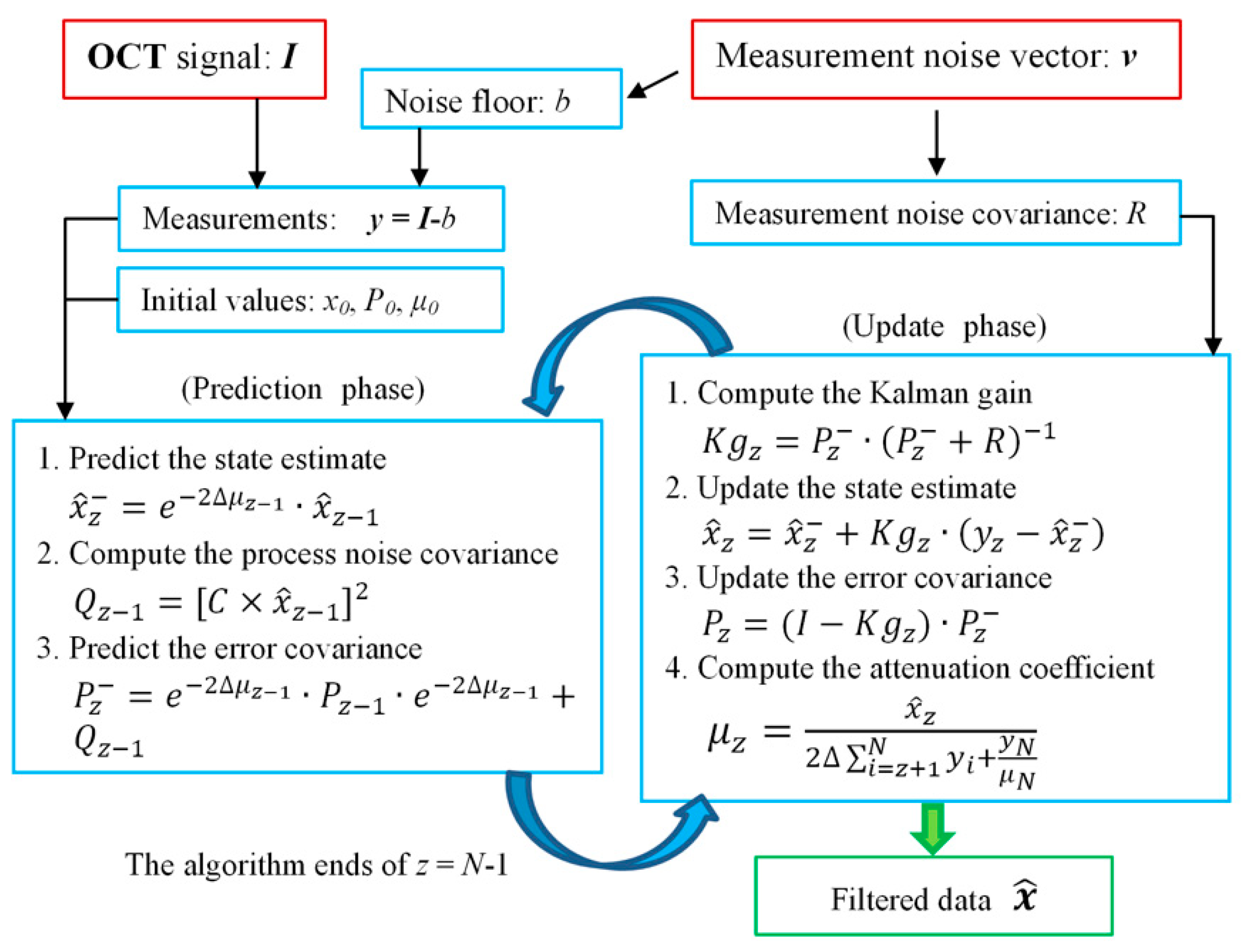


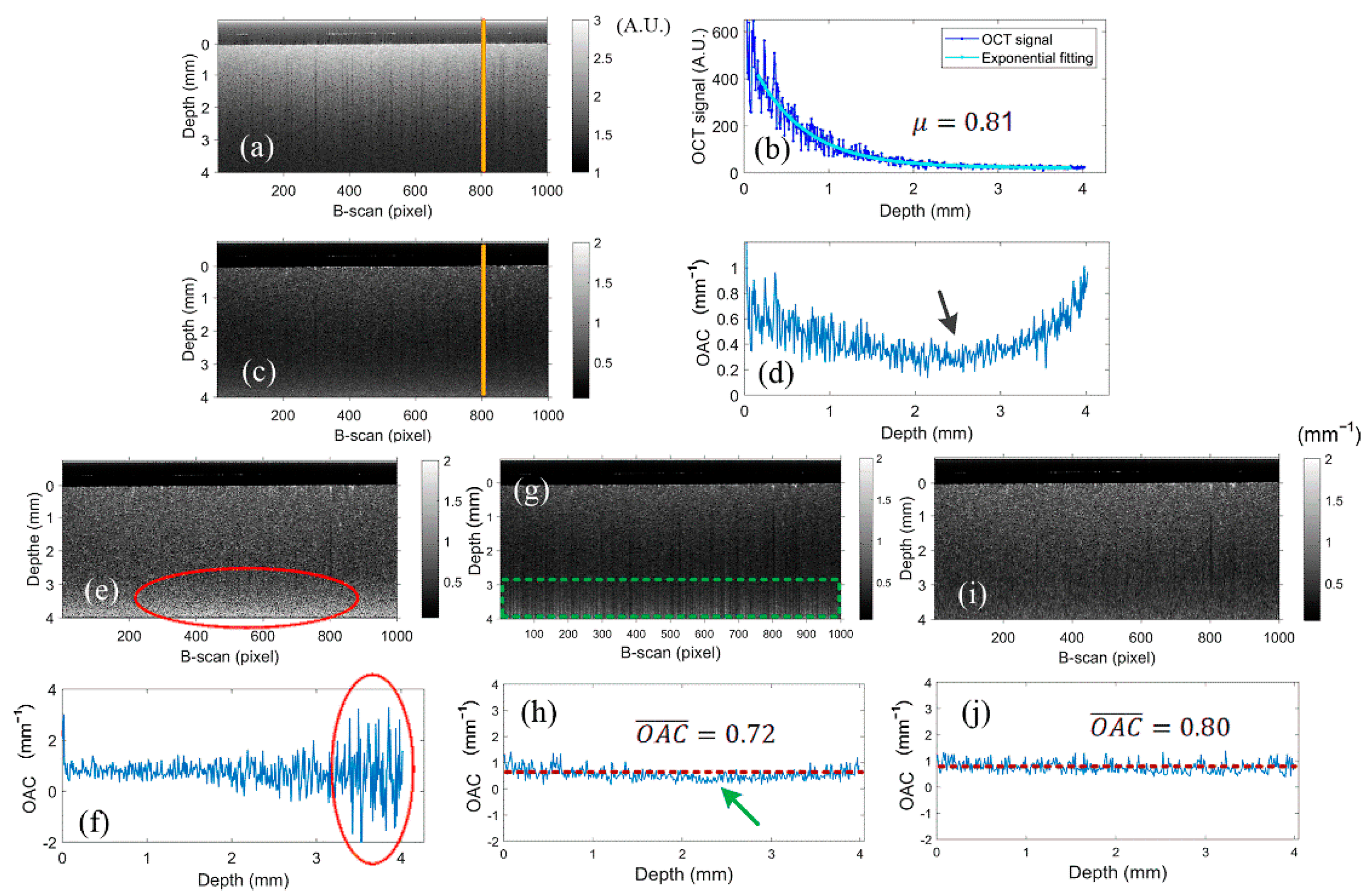
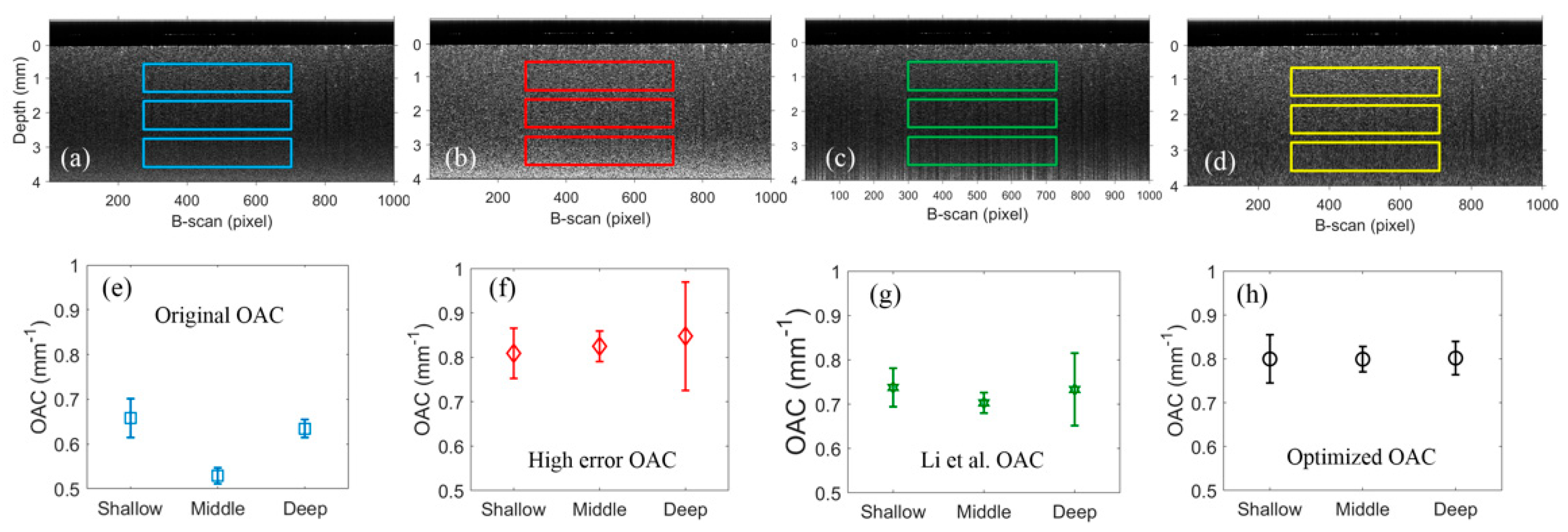
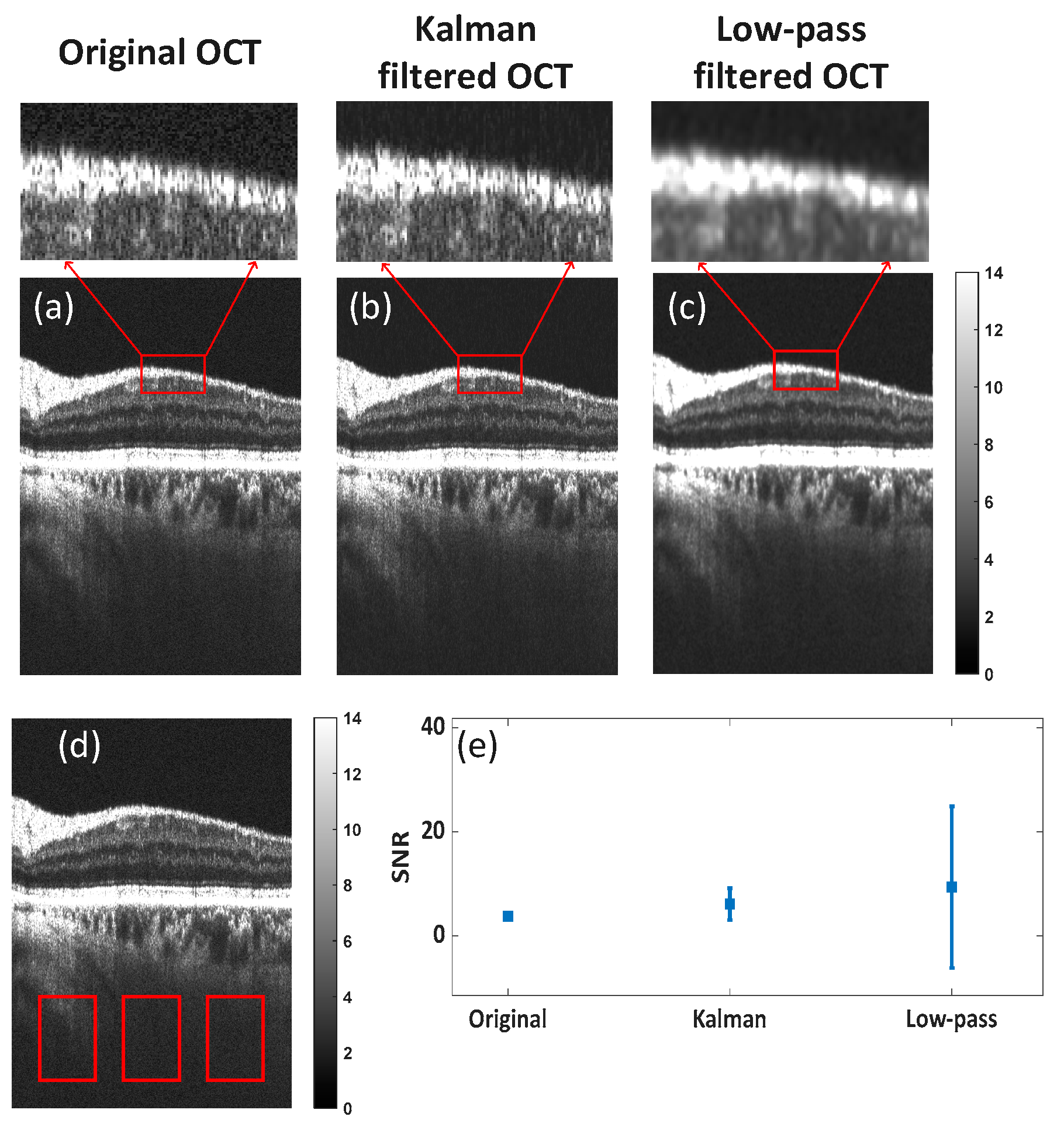

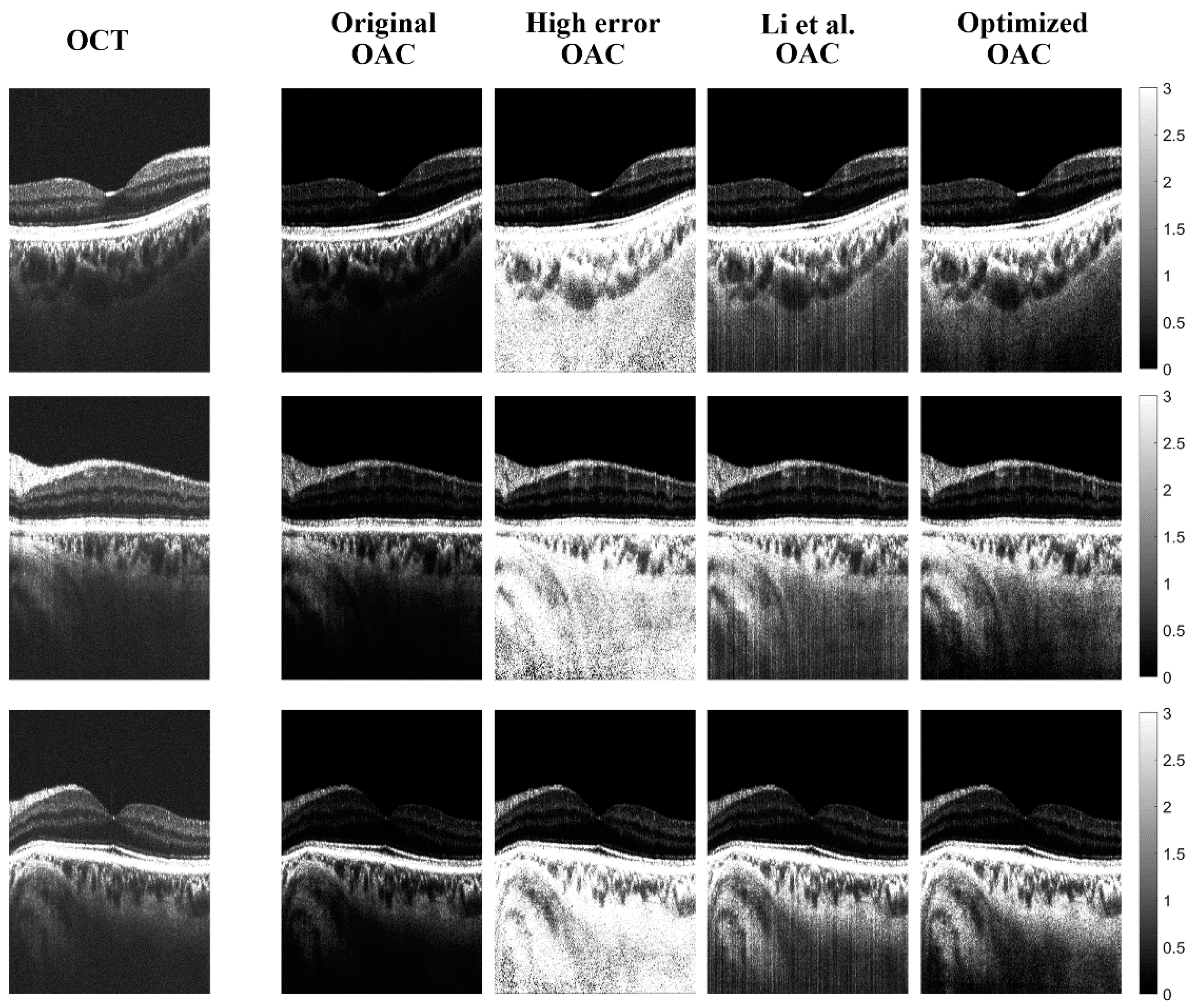
| Prediction: | Predict the state estimate | (5) | |
| Predict the error covariance | (6) | ||
| Update: | Calculate the Kalman gain | (7) | |
| Update the state estimate | (8) | ||
| Update the error covariance | (9) |
Disclaimer/Publisher’s Note: The statements, opinions and data contained in all publications are solely those of the individual author(s) and contributor(s) and not of MDPI and/or the editor(s). MDPI and/or the editor(s) disclaim responsibility for any injury to people or property resulting from any ideas, methods, instructions or products referred to in the content. |
© 2023 by the authors. Licensee MDPI, Basel, Switzerland. This article is an open access article distributed under the terms and conditions of the Creative Commons Attribution (CC BY) license (https://creativecommons.org/licenses/by/4.0/).
Share and Cite
Liu, J.; Chen, Y.; He, Y.; Lu, N.; Yang, D.; Tian, Y.; Yu, Y.; Zhao, Y.; Wang, Y.; Ma, Z. Optical Attenuation Coefficient Optimization Algorithm for Deep Tissue Signals in Optical Coherence Tomography Based on Kalman Filter. Photonics 2023, 10, 460. https://doi.org/10.3390/photonics10040460
Liu J, Chen Y, He Y, Lu N, Yang D, Tian Y, Yu Y, Zhao Y, Wang Y, Ma Z. Optical Attenuation Coefficient Optimization Algorithm for Deep Tissue Signals in Optical Coherence Tomography Based on Kalman Filter. Photonics. 2023; 10(4):460. https://doi.org/10.3390/photonics10040460
Chicago/Turabian StyleLiu, Jian, Yanyu Chen, Yang He, Nan Lu, Dongni Yang, Yu Tian, Yao Yu, Yuqian Zhao, Yi Wang, and Zhenhe Ma. 2023. "Optical Attenuation Coefficient Optimization Algorithm for Deep Tissue Signals in Optical Coherence Tomography Based on Kalman Filter" Photonics 10, no. 4: 460. https://doi.org/10.3390/photonics10040460
APA StyleLiu, J., Chen, Y., He, Y., Lu, N., Yang, D., Tian, Y., Yu, Y., Zhao, Y., Wang, Y., & Ma, Z. (2023). Optical Attenuation Coefficient Optimization Algorithm for Deep Tissue Signals in Optical Coherence Tomography Based on Kalman Filter. Photonics, 10(4), 460. https://doi.org/10.3390/photonics10040460






